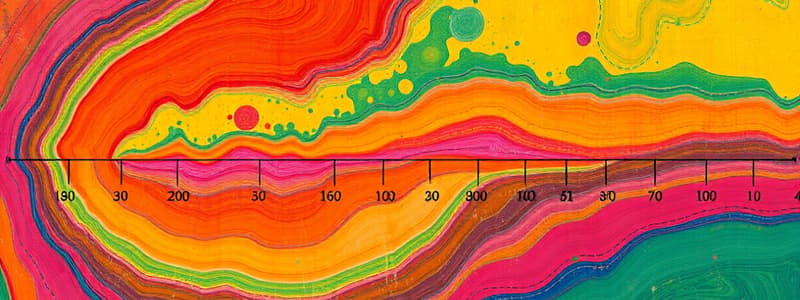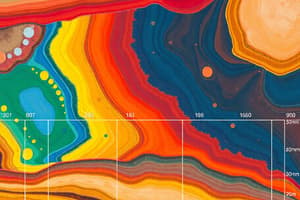Podcast
Questions and Answers
What is the primary purpose of the geologic time scale?
What is the primary purpose of the geologic time scale?
- To chronologically measure stratigraphy and relate it to time (correct)
- To compare the ages of different rock formations
- To predict future geological phenomena
- To describe the physical characteristics of Earth’s crust
Which principle suggests that present-day geological processes can help understand past events?
Which principle suggests that present-day geological processes can help understand past events?
- Paleontology
- Uniformitarianism (correct)
- Catastrophism
- Stratigraphy
What role do marker fossils play in geology?
What role do marker fossils play in geology?
- They provide clues about past climates.
- They indicate the presence of mineral resources.
- They define and identify subdivisions of the geologic time scale. (correct)
- They measure the age of rock layers.
What are stratified rocks primarily formed from?
What are stratified rocks primarily formed from?
Which method determines the age of stratified rocks based on their position in layers?
Which method determines the age of stratified rocks based on their position in layers?
How has the understanding of Earth's history changed in recent decades?
How has the understanding of Earth's history changed in recent decades?
What defines the concept of stratigraphy in geology?
What defines the concept of stratigraphy in geology?
What is one implication of the Earth's active processes on its geological history?
What is one implication of the Earth's active processes on its geological history?
Which period is notable for the emergence of the first jawless vertebrates?
Which period is notable for the emergence of the first jawless vertebrates?
What significant development occurred during the Cambrian Period?
What significant development occurred during the Cambrian Period?
Which organism is considered the earliest fish known during the Silurian Period?
Which organism is considered the earliest fish known during the Silurian Period?
Which period is referred to as the 'age of fishes'?
Which period is referred to as the 'age of fishes'?
During which period did the earliest well-developed circulatory systems appear?
During which period did the earliest well-developed circulatory systems appear?
What was a characteristic of the Carboniferous Period?
What was a characteristic of the Carboniferous Period?
Which of the following marks the distinction of Ordovician rocks?
Which of the following marks the distinction of Ordovician rocks?
What is notable about the marine organisms during the Cambrian Period?
What is notable about the marine organisms during the Cambrian Period?
What is the largest interval of geological time classified in the geological time scale?
What is the largest interval of geological time classified in the geological time scale?
Which eon is characterized by the first appearance of life on Earth?
Which eon is characterized by the first appearance of life on Earth?
When did the Paleozoic era begin in relation to Earth's history?
When did the Paleozoic era begin in relation to Earth's history?
Which of the following best describes the Mesozoic era?
Which of the following best describes the Mesozoic era?
What is the main characteristic of the Phanerozoic Eon?
What is the main characteristic of the Phanerozoic Eon?
Which event is specifically associated with the Paleozoic era?
Which event is specifically associated with the Paleozoic era?
The term 'Precambrian time' refers to which span of time?
The term 'Precambrian time' refers to which span of time?
What significant geological feature is associated with the Mesozoic era?
What significant geological feature is associated with the Mesozoic era?
What significant event marks the beginning of the Triassic Period?
What significant event marks the beginning of the Triassic Period?
Which of the following groups dominated the landscape during the Triassic Period?
Which of the following groups dominated the landscape during the Triassic Period?
What was the main reason for the reptiles' long reign on Earth?
What was the main reason for the reptiles' long reign on Earth?
What major climatic change occurred during the Permian Period?
What major climatic change occurred during the Permian Period?
Which of the following events resulted in the loss of 90% of oceanic life?
Which of the following events resulted in the loss of 90% of oceanic life?
During which period did Pangaea begin to break apart?
During which period did Pangaea begin to break apart?
What type of structures did some plants develop during the Jurassic Period?
What type of structures did some plants develop during the Jurassic Period?
What is the approximate time frame of the Jurassic Period?
What is the approximate time frame of the Jurassic Period?
Which marine mammal groups first appeared in the fossil record during the Oligocene?
Which marine mammal groups first appeared in the fossil record during the Oligocene?
What significant climatic event marks the beginning of the Oligocene epoch?
What significant climatic event marks the beginning of the Oligocene epoch?
How did the climate during the Miocene epoch compare to the Oligocene?
How did the climate during the Miocene epoch compare to the Oligocene?
What major climatic changes occurred during the late Miocene?
What major climatic changes occurred during the late Miocene?
Which two epochs subdivide the Quaternary Period?
Which two epochs subdivide the Quaternary Period?
What were the effects of the Quaternary Period's climatic changes?
What were the effects of the Quaternary Period's climatic changes?
At the peak of the Pleistocene glacial ages, what percentage of Earth's land area was covered by glacial ice?
At the peak of the Pleistocene glacial ages, what percentage of Earth's land area was covered by glacial ice?
Which of the following statements about the Pleistocene epoch is correct?
Which of the following statements about the Pleistocene epoch is correct?
Flashcards are hidden until you start studying
Study Notes
Geologic Time Scale
- The geologic time scale is a system of chronological measurement that relates stratigraphy to time.
- Earth's history is divided into eons, eras, periods, and epochs.
Eons
- Archean Eon: This is the period when life first formed on Earth. It also saw the formation of continents and oceans.
- Proterozoic Eon: This period marks the time before the proliferation of complex life. It was characterized by extensive shallow seas.
- Phanerozoic Eon: This is the period of visible life. Rapid expansion and evolution of life forms occurred during this time.
Precambrian Time (Pre-Phanerozoic)
- This encompasses the time between Earth's formation and the beginning of the Paleozoic Era, ranging from 4.6 billion years ago to about 544 million years ago.
- This time is referred to as the "time of hidden life" as life was primarily microscopic.
Eras
- Paleozoic Era: This is referred to as the "time of ancient life." It began with the first appearance of organisms with hard parts.
- Mesozoic Era: This is referred to as the "time of middle life." This era saw the extinction of dinosaurs and many other organisms.
- Cenozoic Era: This is referred to as the "time of recent life." It marked the extinction of various mammals and prehistoric creatures.
Periods of the Paleozoic Era
- Cambrian Period: This period is marked by the evolution of organisms with the ability to secrete calcium carbonate and calcium phosphate for the formation of shells, including chordates, resembling clams and arthropods.
- Ordovician Period: This period is marked by the earliest emergence of vertebrates and jawless fish known as Agnatha. This period is also notable for the presence of Ordovician rocks at the highest elevation on Earth (Mount Everest).
- Silurian Period: This period is notable for the emergence of terrestrial life, including vascular plants (Cooksonia) and air-breathing scorpions and millipedes.
- Devonian Period: This period is known as the "age of fishes." The development of sharks, bony fishes, and the first amphibians occurred during this time.
- Carboniferous Period: This period was characterized by a warm, moist climate, leading to the development of dense, swampy forests and the rapid evolution of insects, including giant cockroaches and dragonflies.
- Permian Period: This period saw the assembly of smaller continents into a supercontinent known as Pangea, surrounded by a vast ocean called Panthalassa. Reptiles thrived during this time.
Periods of the Mesozoic Era
- Triassic Period: This period began after Earth's worst extinction event, the Permian-Triassic extinction event, also known as the "Great Dying". This period saw the formation of a supercontinent known as Pangaea.
- Jurassic Period: This period saw the breakup of Pangea into the present-day continents. Marine reptiles like plesiosaurs and ichthyosaurs flourished.
- Cretaceous Period: This period saw the rise of flowering plants and dinosaurs including Tyrannosaurus Rex, Stegosaurus, and Triceratops, followed by the extinction of dinosaurs.
Periods of the Cenozoic Era
- Tertiary Period: This period is further divided into epochs like the Oligocene, Miocene, and Pliocene.
- Quaternary Period: This is the most recent period and is divided into the Pleistocene and Holocene epochs. It is characterized by major cyclical climate changes, including ice ages.
Epochs of the Tertiary Period
- Oligocene Epoch: This epoch is marked by a decrease in Earth's temperature and the formation of a permanent ice cap at the South Pole.
- Miocene Epoch: This epoch saw a rebound in Earth's temperature, leading to an increase in mammal species.
- Pliocene Epoch: This epoch saw global drying and cooling, with the retreat of rainforests.
Epochs of the Quaternary Period
- Pleistocene Epoch: This epoch is defined by glacial ages, with more than 30% of Earth's land area covered in ice.
- Holocene Epoch: This epoch is known as the "Recent Epoch" and stretches from the end of the last glacial period, around 11,700 years ago, to the present day. The Holocene is the current geological epoch.
Studying That Suits You
Use AI to generate personalized quizzes and flashcards to suit your learning preferences.




